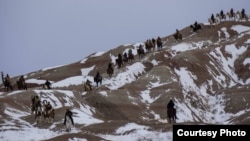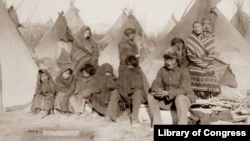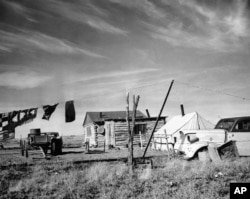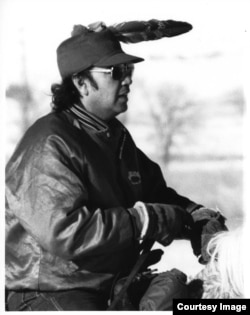Dozens of Lakota and other Native American allies are about to converge on Bridger, South Dakota, for a pilgrimage they've made every December for the last 32 years: a 300-kilometer journey on horseback, retracing the historic journey, of a Lakota chief and 350 of his followers, that ended in a massacre.
Alex White Plume, a former president of the Oglala Sioux on the Pine Ridge Reservation, is a founding member of the ride, which he organized in 1986 on the advice of his uncle, a spiritual interpreter.
"My uncle said that we had to do some grieving over the historic genocide of our people," said White Plume. "As Lakota, our whole purpose is to be pure from trauma, ill feelings, guilt. But the historic genocide weighed so heavily on us that we couldn't think past it."
His uncle told him they had to bring back the grieving ritual, which Lakota no longer practiced. And to do that, White Plume needed to go back to the place where the Lakota's collective grief began.
Massacre at Wounded Knee
In mid-December 1890, acting on government orders, tribal police arrested and killed Hunkpapa Lakota leader Sitting Bull outside of his cabin on the Standing Rock reservation. His death came at a time when the government was on edge, worrying that Plains tribes were plotting rebellion against the abysmal conditions on reservations
Fearing for his people's safety, Sitting Bull's ally, Minneconjou Lakota leader Spotted Elk (dubbed "Big Foot" by the cavalry for the size of his shoes), fled south to the Pine Ridge Reservation with about 350 Lakota, most of them women and children.
The Army intercepted the travelers, who submitted peacefully and made camp along Wounded Knee Creek in Pine Ridge. On the morning of December 29, the Army began a search for weapons. A shot rang out — who fired and why is still not clear.
The Army opened a barrage of rifle, pistol and revolving cannon fire.
Spotted Elk was among the first to fall, and 30 minutes later, as many as 300 Lakota lay dead — adults, children, and even infants. It wasn't until three days later that Army contractors gathered the dead and buried them in a mass grave at the rate of $2 per body.
The massacre marked the end of the Indian Wars, ushering in an era of subjugation, forced assimilation and broken treaties.
Wiping the tears
By the late 20th century, Pine Ridge was one of the poorest spots in the United States. Unemployment hovered at 80 percent, housing was substandard, and life expectancy was the second lowest in the Western Hemisphere. Lakota language, culture and spiritual beliefs were all but lost, and the Nation lived in a state of grief and despair.
In the early 1980s, White Plume's uncle told him that because the Army had not allowed survivors and family members to perform grieving ceremonies at Wounded Knee, the spirits of the victims had not been able to leave the "Land of the Breathing."
To remedy this, in 1986, White Plume, his brother Percy and 17 other Lakota, calling themselves the Si Tanka Wokiksuye Okolakiciye — "Spotted Elk Remembrance Group" — embarked on the first annual Big Foot Memorial Ride from Standing Rock to Pine Ridge.
It was an emotional experience, a time to remember the past and reflect on the future.
"As men, we cried," said White Plume. "We used to try to be like the white man — don't show any pain and just be tough. But after you go through that ride, it's okay to cry. It heals your wounds."
After the fourth ride in 1989, the group decided to continue the tradition indefinitely, allowing youth to participate. They dubbed the event the "Future Generation Ride."
In 1990, riders conducted a Wiping the Tears ceremony at Wounded Knee, ending more than a century of mourning by seven successive generations of Lakota and acknowledging to the world, said White Plume, "We're still here; our culture is intact."
That same year, Congress issued a resolution acknowledging "deep regret" for the massacre but offered no formal apology.
Culture revived
Today, said White Plume, Lakota have brought back their ceremonies, performing dozens of Sundances alone each summer on Pine Ridge.
"And, oh! It's beautiful to see," he said.
This year's ride begins Sunday. White Plume and dozens of riders, old and young, will saddle their horses for the seven-day ride across the frigid Plains, stopping, saddle sore, to camp at night.
It's an arduous journey, but White Plume said he doesn't feel the cold or the pain of hours in the saddle. "You just get into this spiritual realm I can't describe. It's a beautiful, peaceful feeling. I have a hard time breaking away from it to come back to reality."












